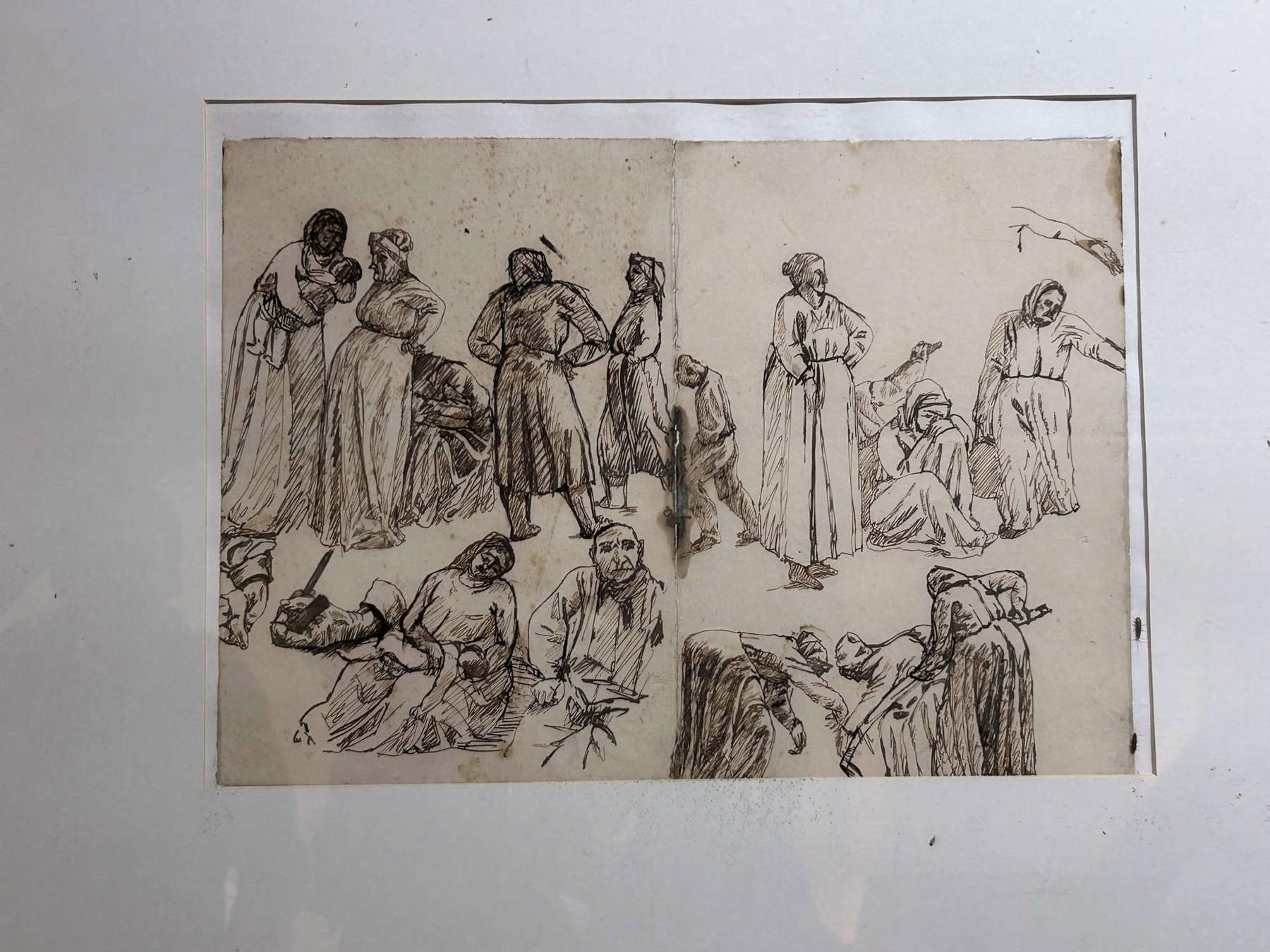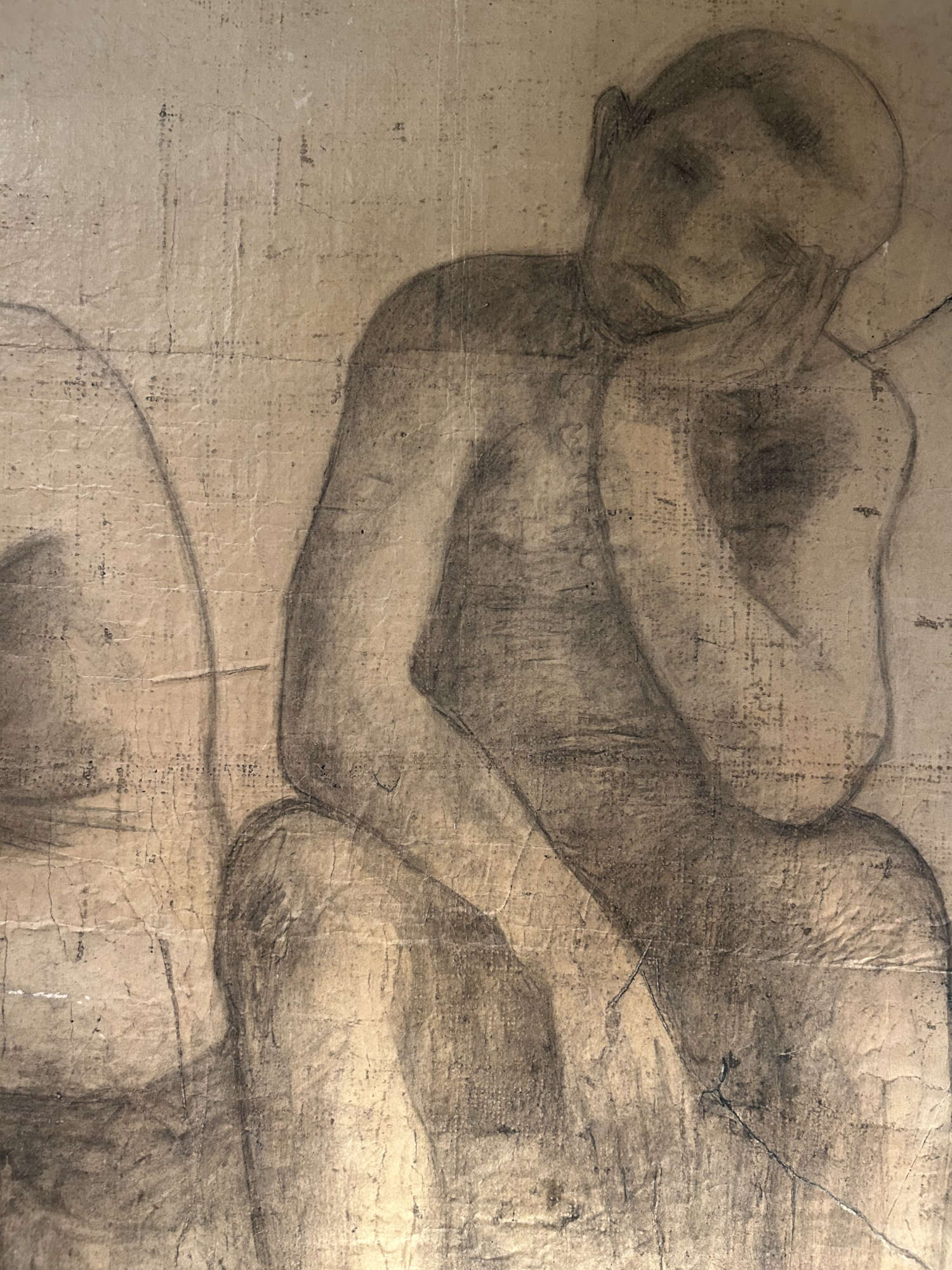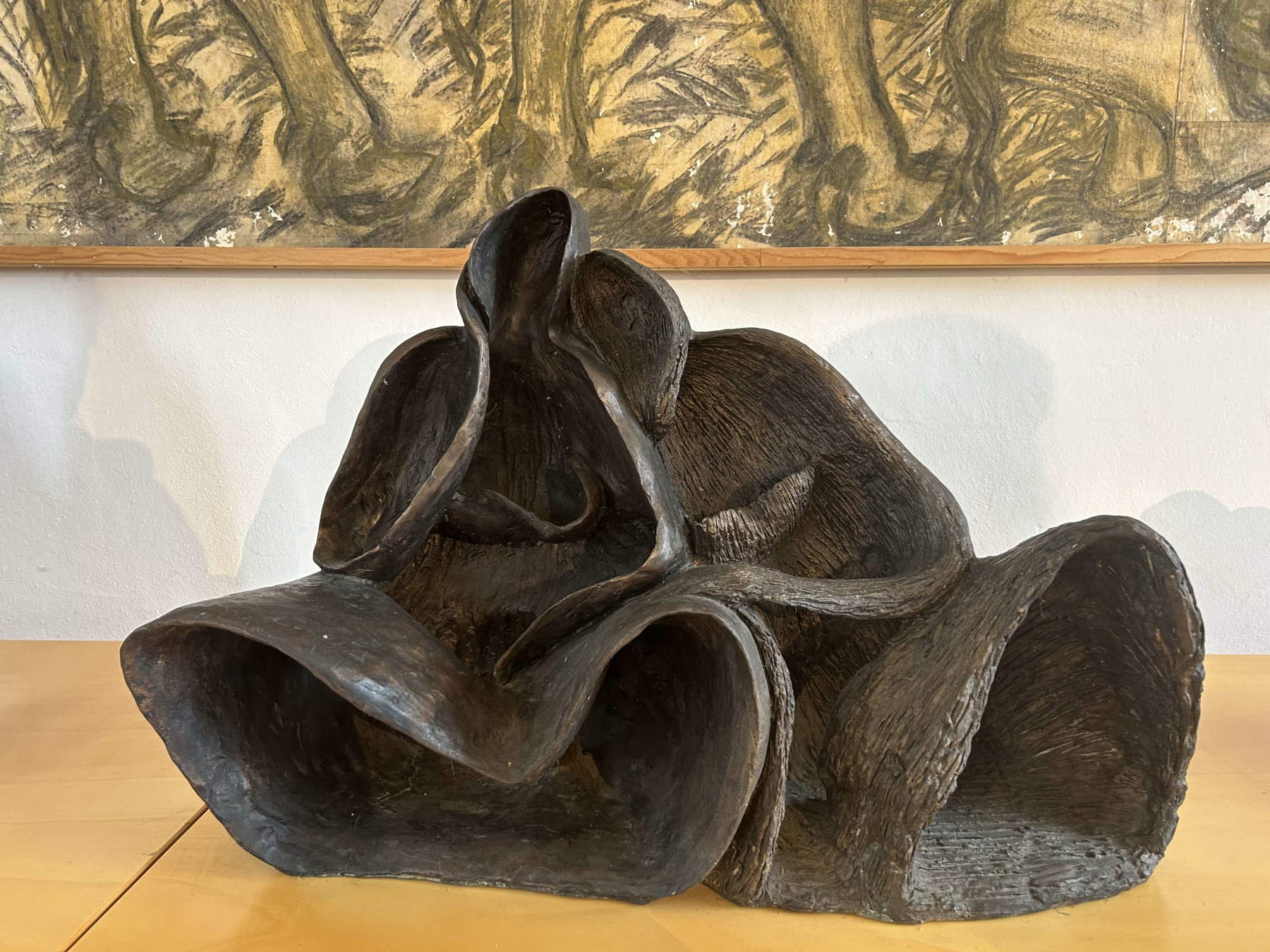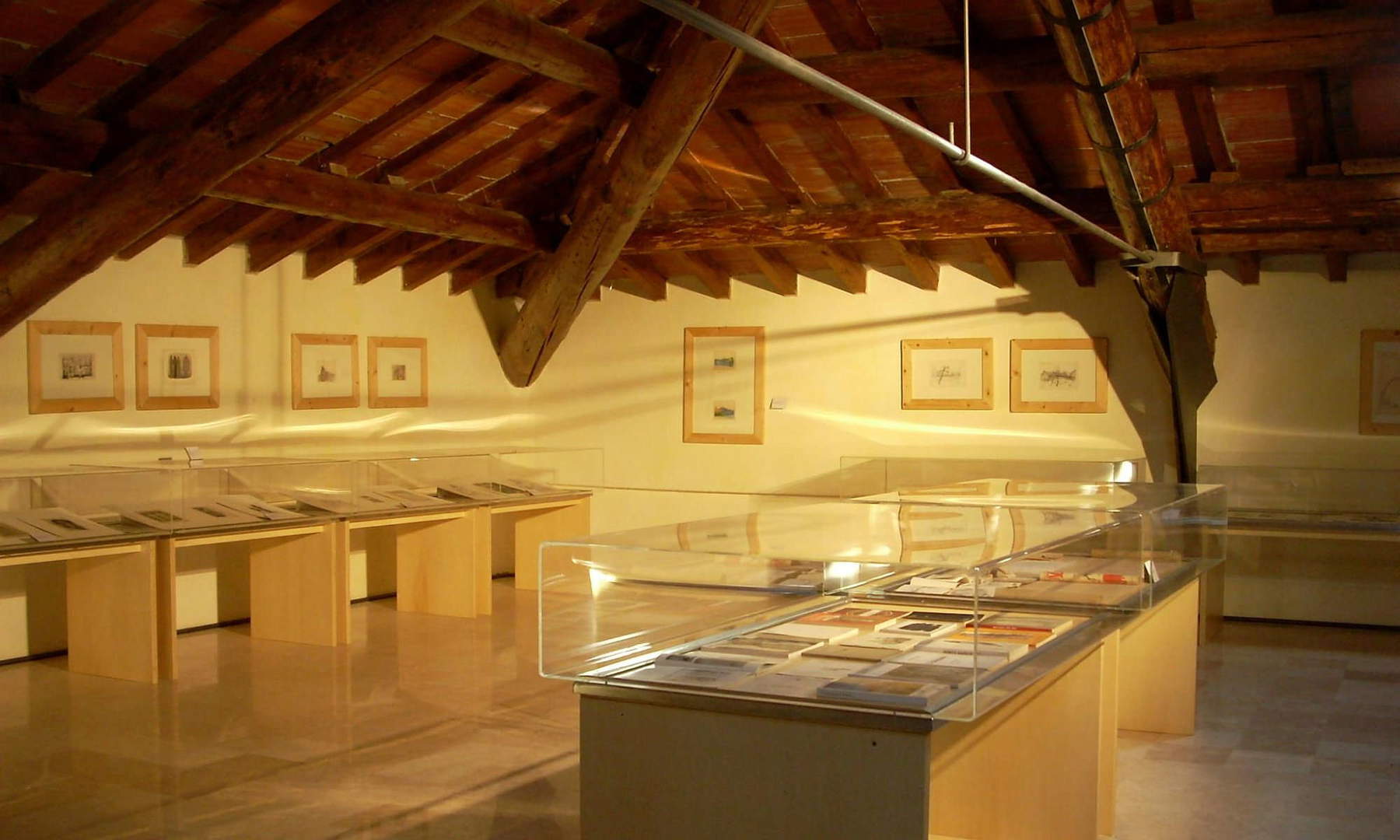An artist who was able to translate into sculptural forms the essence of rural life in the Lower Po Valley, shaping the material to give voice to the stories of a people, their visions, their emotions: this is how we could define Giuseppe Gorni (Quistello, 1894 - Domodossola, 1975), a sculptor whose work is deeply rooted in the Mantuan territory and who today finds new life in the Museo Diffuso of Quistello, the place that preserves the memory of his work.
Not only a sculptor (although he is mostly known as such), but also a painter and engraver, Gorni left a relevant mark on the Mantuan territory both for the quality of his works and for his dedication to the telling of traditions and rural life. His own life is marked by a deep connection with the land and a passion for art.



Gorni was born on March 27, 1894, in the hamlet of Santa Lucia di Quistello, in the province of Mantua. His artistic training began at the Academy of Fine Arts in Bologna, after which Gorni earned the title of middle school teacher. After the dramatic experiences of World War I, during which he was a prisoner in the Hajmasker camp in Hungary (he was captured on the Asiago plateau, where he fought), Gorni returned to Quistello to devote himself to art and teaching. His career was marked by social commitment and staunch opposition to the Fascist regime, which forced him to leave his post as director of the Quistello Technical Schools he founded after World War I.
The following years saw Gorni deeply engaged in the cultural and artistic life of his homeland: he was interrupted only, again, by the events of the war (he was in fact called to arms on May 24, 1940, fought in France and Russia between 1941 and 1943, and finally was interned in a military camp in Switzerland). Only in 1945 was he able to resume his teaching role, first in Quistello and then in Mantua. Gorni devoted himself to an artistic production that resulted in an intense study of peasant traditions, actively participating in the recovery and enhancement of local histories. His artistic career developed significantly in the 1960s and 1970s, with his return to Nuvolato di Quistello (in the 1950s he actually lived in Cinisello Balsamo, in the Milanese hinterland, where he worked as head of the municipality’s technical office), where he was able to devote himself entirely to sculpture, drawing and engraving. His art, rooted in collective memory and rural life, gained increasing recognition, culminating in his first exhibition in Milan in 1965, and later in exhibitions that spread awareness of his work.





The Museo Diffuso in Quistello is a tribute to the life and work of Giuseppe Gorni. The building that houses it, designed by the artist himself between 1929 and 1930, namely the Giovanni Pascoli Elementary Schools, is itself an architectural work that gives evidence of his art: a structure characterized by essential lines and natural materials that blend perfectly into the surrounding landscape. The building, moreover, was restored in 2002. The exhibition itinerary, on the other hand, is a journey through Gorni’s artistic production, from his early youthful works, characterized by a frank and direct realism, to his mature sculptures, where form becomes more essential and meaning more profound.
However, the concept of a “diffuse museum” translates into an itinerary that, as will be seen, extends beyond the walls of the museum, involving the entire territory of Quistello. Indeed, Gorni’s works can also be found in symbolic places in the area, in the public spaces of the town. This approach emphasizes the artist’s deep rootedness in his territory and invites visitors to explore the landscape that inspired his work.
On the second floor of the museum, the sculpture section focuses on the evolution of Gorni’s technique, but especially on the themes that fascinated him most: the depiction of the female figure, a symbol of the power of nature and fertility, and the simpler, more genuine humanity. His sculptures, such as those showing women with wide hips and prosperous breasts, are symbols of the generating power of nature, and reflect a world that is primal, but also extremely human. “When you represent a thing with the main form of its intimacy or essence,” Gorni had to write, “it acquires greater potentiality.” The sculpture room is a tribute to Gorni’s entire career.
The second floor of the museum, on the other hand, is devoted to graphic art and is divided into two rooms. The first section is a journey into Gorni’s mind during his early formative years, with drawings depicting rural life in the lower Po Valley, a world of farmers and working animals. These drawings are an expression of a strong cultural identity, uniting man to his natural environment in an inseparable way. Gorni’s art evolved over time, and his experience as a prisoner of war, lived in a prison camp, marked a change in his approach to the human figure. In fact, in this period (an entire section of the museum is dedicated to the Hajmasker camp), his drawings show men without identity, reduced to silhouettes that blend into geometric and symbolic shapes, as if to express the dehumanization experienced in the lager. In contrast, in his later works, such as those made during his stay in Saracena, Calabria, Gorni rediscovers hope and depicts more serene scenes of daily life, centered on peasants and women, also inspired by memories of his childhood.
The second room of graphics houses a collection of etchings and sketches that highlight Gorni’s willingness to experiment with different artistic techniques. In these works, the artist explores sculpture through drawing, creating figures that seem suspended between fullness and emptiness. The etchings reflect intense formal research, where each mark is part of a process of synthesis and refinement. Between 1924 and 1927, Gorni devoted himself to etching and woodcut, placing these practices alongside sculpture, one of his greatest passions. These works are an expression of a continuous evolution, in which the artist sought to make form purer and more communicative, without ever losing touch with the concrete reality that surrounded him.




Gorni’s work is deeply rooted in the Mantuan territory. His sculptures, which depict figures of farmers, animals and landscapes, are the result of careful observation of the surrounding reality. Gorni has been able to capture the essence of rural life, conveying through his works a sense of belonging. The choice of materials is another key element in the link between Gorni and the land: the artist has mainly used local materials, such as wood, stone and terracotta, creating works that seem to emerge from the land itself. His choice to return to Nuvolato after years of working elsewhere testifies, after all, to a strong attachment to his origins. And this connection is evident in his works, which celebrate the values of the rural community, the beauty of the landscape and the historical memory of the place.
Yet despite the strong connection to the land, Gorni’s work has ambitions of universality. His sculptures, in fact, speak of existential themes such as life, death, loneliness and hope, themes that are common to all human beings and that are conveyed by Gorni through a formal simplicity combined with an expressive force that make his works immediate, communicative and intense.
The Mantuan artist has been influenced by different artistic movements, such as the Italian Novecento and realism, but he has been able to elaborate a personal and original language. Although he did not adhere to any particular artistic current, Gorni established a fruitful dialogue with other artists of his generation, such as Marino Marini and Arturo Martini , whose influence is evident when observing his works.


The Giuseppe Gorni Diffuse Museum expands beyond the confines of its walls by offering three distinct itineraries that weave art, history and architecture directly into the Quistello area. These itineraries allow you to explore Gorni’s work not only through his creations displayed in the museum, but also in the public places and rural areas that inspired him.
The first route starts from the museum and develops toward theAiuola dei Gelsi, where the mural Il Girotondo and its pendant I bambini che entrano a scuola and the sculpture I due Gelsi are located, representing the artist’s deep connection with nature and community. The walk continues through the town center, where visitors can discover other murals and graffiti works scattered among houses and public places.
Again, the second route, the “Streets of the Center,” offers a walk that explores Gorni’s presence in the public and private architecture of Nuvolato, where other examples of buildings he designed (such as the house of theorchardist of 1926, the carpenter’s house of 1928 and the baker’s house of the same year, or the Gorni House known as “The Savage” of 1929-1930) and of his wall works, such as murals and bas-reliefs (e.g., the Card Players of 1961 and the Embroiderers of 1965) that decorate various buildings in the village. Each corner becomes a fragment of artistic history, an invitation to discover how Gorni’s art merged with his surroundings, creating an open-air museum that runs through the streets and symbolic places of Quistello.
Finally, a third route winds from the Pieve di San Fiorentino to the Nuvolato cemetery, where Gorni left his mark with monuments and sculptures that tell a more intimate and spiritual side of his art. Among the graves and monuments of the cemetery, visitors can admire the work Woman Entering the Cemetery, a masterpiece that reflects the artist’s vision of death and immortality. This itinerary adds a meditative dimension to the experience of the Museo Diffuso.
The Giuseppe Gorni Diffuse Museum is not only a place for the preservation and enhancement of artistic heritage, but also a dynamic and active cultural center. The museum organizes a rich program of educational activities, workshops and events, aimed at a public of all ages. Thanks to these initiatives, the museum becomes a place of encounter and exchange, where art becomes a tool for learning about ourselves and the world around us.
In fact, the institute does not want to limit itself to being a container of works, but becomes a kind of “diffuse museum” in the true sense of the word, with the works coming out of the rooms to invade the country. Gorni in fact created, as mentioned, numerous wall works, murals and bas-reliefs that are scattered throughout the municipality of Quistello, creating a connection between his work and the local community. This “diffuse” approach makes it possible to experience art in an integrated way with the territory, so that the museum becomes not only a place of preservation, but an authentic meeting point between art, history and community, where every corner tells of the life and works of an artist who was able to combine his aesthetic sensibility with the daily reality of his land. And his art, in this way, becomes a glue between different generations and even different cultures.
Advertorial article produced as part of the project “Paths of popular art along embankments and floodplains” - Municipality of Quistello - Consorzio Oltrepò Mantovano - Lombardy Style - inLombardia - With the contribution of Lombardy Region

Warning: the translation into English of the original Italian article was created using automatic tools. We undertake to review all articles, but we do not guarantee the total absence of inaccuracies in the translation due to the program. You can find the original by clicking on the ITA button. If you find any mistake,please contact us.